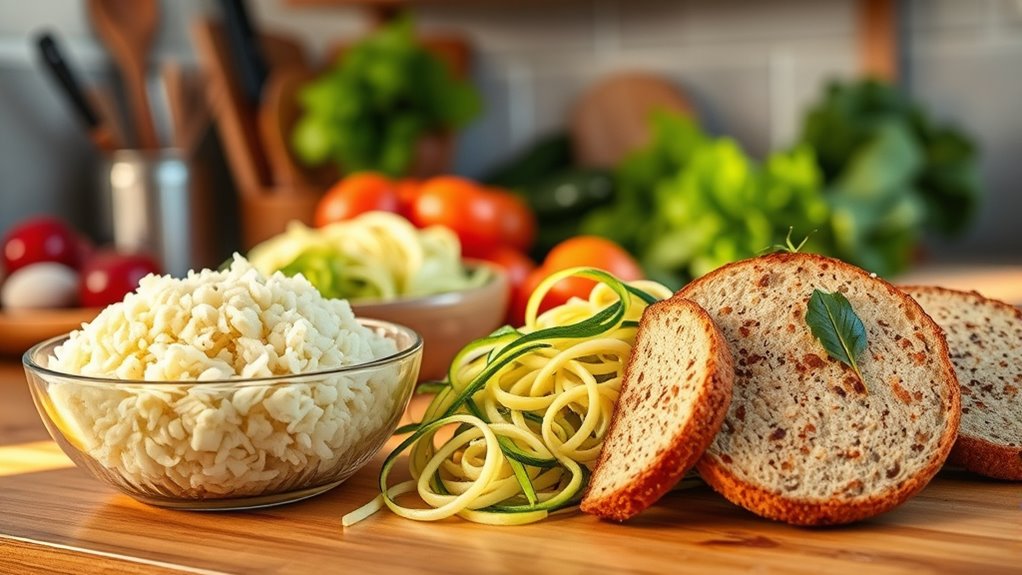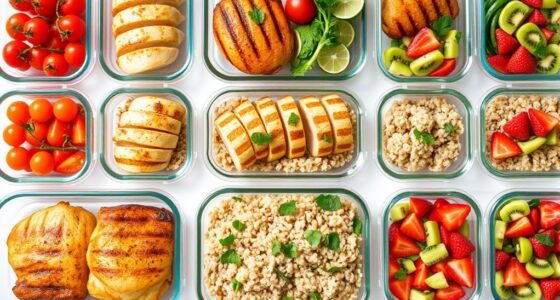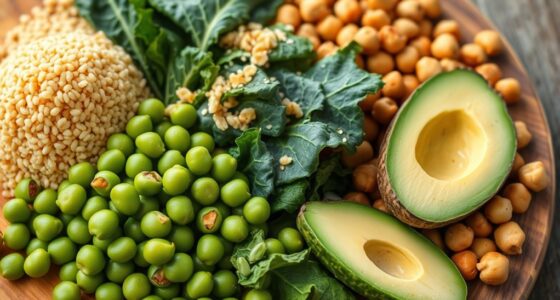To master low-carb cooking, try cauliflower rice as a rice replacement, zucchini or konjac noodles instead of pasta, and almond or coconut flour bread for baking. These alternatives help you stay within keto or low-sugar diets while still enjoying your favorite dishes. They’re easy to prepare, versatile, and taste great. Keep exploring these substitutes to discover more tasty, health-conscious options that fit your lifestyle seamlessly.
Key Takeaways
- Cauliflower rice offers a low-carb, versatile alternative to traditional rice, absorbing flavors well in various dishes.
- Spiralized vegetables like zucchini or cucumber serve as fresh, crisp, low-carb pasta substitutes suitable for different recipes.
- Almond or coconut flour-based breads provide satisfying, high-fiber options that align with ketogenic diet goals.
- Using sugar substitutes such as stevia or erythritol allows sweetening without disrupting ketosis.
- These low-carb alternatives help manage blood sugar, support sustained energy, and facilitate quick, healthy meal prep.

If you’re looking to improve your diet, understanding the basics of low-carb cooking is a great place to start. One of the biggest challenges is finding satisfying alternatives for traditional carbs like rice, pasta, and bread. Fortunately, there are many options that fit within a ketogenic diet, helping you reduce carbs without sacrificing taste or texture. Replacing rice can be as simple as using cauliflower rice, which is simply grated cauliflower cooked lightly until tender. It mimics rice’s texture and absorbs flavors well, making it a versatile base for stir-fries, salads, or bowls. For pasta, spiralized vegetables like zucchini or cucumber serve as excellent substitutes. These vegetable noodles are low in carbs and add a fresh, crisp bite to your meals. You can also try shirred or konjac-based noodles, which are made from fiber-rich ingredients that contain minimal carbs. When it comes to bread, options like almond flour or coconut flour-based bread provide satisfying alternatives that are high in healthy fats and fiber, fitting well within a ketogenic diet. These breads often have a denser texture but can be toasted or topped with your favorite spreads for a satisfying snack. Incorporating remote work benefits such as flexibility can also make meal prep and maintaining your low-carb diet more manageable within your busy schedule.
Sugar substitutes also play a pivotal role in low-carb cooking, especially when you’re craving something sweet. Traditional sugar is high in carbohydrates and can quickly knock you out of ketosis, so replacing it with alternatives like stevia, erythritol, or monk fruit sweetener helps you satisfy your sweet tooth without the spike in blood sugar. These sugar substitutes are many times sweeter than sugar, so a little goes a long way. They work well in baking, beverages, and desserts, allowing you to enjoy treats without compromising your low-carb or ketogenic goals. Keep in mind that some sugar substitutes can have aftertastes or digestive effects, so experiment to find the ones you prefer. Using these alternatives can also help you reduce overall sugar intake, which benefits your health and supports sustained energy levels.
Frequently Asked Questions
Are Low-Carb Substitutes Suitable for All Dietary Restrictions?
Low-carb substitutes aren’t suitable for all dietary restrictions, especially if you have gluten intolerance or a vegan diet. Many alternatives contain gluten or animal products, so you need to check labels carefully. For gluten intolerance, look for gluten-free options. Vegans should choose plant-based substitutes. Always read ingredient lists to verify they meet your specific needs, and consult with a healthcare professional if you’re unsure about compatibility with your restrictions.
How Do Low-Carb Options Affect Meal Preparation Time?
Low-carb options can improve your meal prep efficiency by reducing cooking time and simplifying ingredient prep. Since many low-carb substitutes like cauliflower rice or zucchini noodles require less cooking or can be prepared quickly, you save time. However, ingredient availability may vary, so shopping for these alternatives might take extra effort initially. Overall, once stocked, they streamline meal prep, making your cooking process faster and more efficient.
Can Children or Elderly Safely Consume Low-Carb Alternatives?
Children and elderly can safely consume low-carb alternatives if you consider their nutritional needs and allergy considerations. You should guarantee these options provide essential nutrients to prevent deficiencies and check ingredient labels for potential allergens. Consulting with a healthcare professional is wise, especially for the elderly or kids with specific health conditions. Always introduce new foods gradually, monitoring for any adverse reactions or allergies to keep everyone safe.
What Are Cost Differences Between Traditional and Low-Carb Ingredients?
While traditional ingredients like rice and bread often cost less, low-carb alternatives can be pricier. You’ll find a noticeable difference in ingredient cost and price comparison, especially with options like cauliflower rice or almond flour. However, investing in these may save you money long-term if they help you meet your health goals. Expect to pay more upfront, but weigh this against potential health benefits and reduced grocery bills over time.
Do Low-Carb Options Impact Satiety and Hunger Levels?
Low-carb options can boost your satiety and help control hunger because they often include higher fiber intake, which slows digestion and keeps you full longer. By choosing alternatives like cauliflower rice or zucchini noodles, you get more fiber and fewer carbs, making it easier to manage appetite. This way, you stay satisfied and reduce cravings, supporting your low-carb diet goals effectively.
Conclusion
Now that you know some tasty low-carb alternatives, you’re ready to transform your meals. Think of these swaps like a secret ingredient that keeps your dishes exciting without the carbs. Just like a smooth jazz tune, your new recipes will flow effortlessly, satisfying your cravings and supporting your health goals. Embrace these options and enjoy the delicious journey toward a low-carb lifestyle—you’ll soon wonder how you ever cooked without them!








